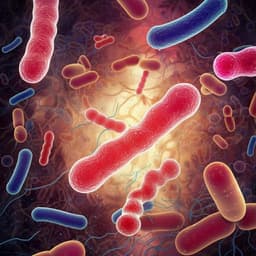
Agriculture
A non-classical route of efficient plant uptake verified with fluorescent nanoparticles and root adhesion forces investigated using AFM
S. Sharma, M. Muddassir, et al.
Discover how hydrophobic oleylamine-coated Cu₂ₓSe nanoparticles outperform their hydrophilic counterparts in tomato plant uptake efficiency. This groundbreaking research by Sandeep Sharma, Mohd. Muddassir, and their colleagues reveals intriguing insights into NP interaction and potential applications in fertilizer delivery.
~3 min • Beginner • English
Introduction
The study investigates whether hydrophobic nanoparticle (NP) surfaces can enhance plant root uptake via a non-classical, adhesion-driven mechanism compared to conventional hydrophilic NPs. Classical plant uptake pathways (passive diffusion, mass flow, ion exchange, and active carrier-mediated transport) generally favor hydrophilic species. Prior work in phytonanotechnology shows NPs can affect photosynthesis, redox balance, nutrient delivery, and intracellular trafficking, with transport via symplastic and apoplastic routes and influences from surface coatings and charge. The authors hypothesize that rendering NPs hydrophobic (oleylamine-coated Cu₂ₓSe, CS@OA) will increase adhesion at the root interface and facilitate forced penetration into roots more efficiently than hydrophilic analogs (chitosan-coated Cu₂ₓSe, CS@CH). They further propose that differences in protein corona formation on NPs within roots may impact subsequent root-to-shoot translocation. The work uses tomato as a model crop and combines uptake quantification, imaging, AFM adhesion force measurements, protein corona profiling, and toxicity assays to elucidate mechanisms and implications for agro-nanotechnology.
Literature Review
Evidence across metals, metal oxides, chalcogenides, and carbon nanomaterials indicates passive and carrier-mediated NP uptake in plants, with movement via xylem and phloem. Surface chemistry (e.g., citrate coatings, charge) modulates uptake. Hydrophobicity combined with mild hydrophilicity can strongly pin water droplets and is associated with enhanced penetration of lipid membranes by NPs in aqueous media. Prior forced-injection NP delivery to plants can be effective but is impractical at scale, motivating alternative approaches leveraging surface hydrophobicity to increase adhesion and uptake. Reports also highlight that NP speciation, dissolution (e.g., CeO₂), and protein corona formation in animals influence bio-distribution; the role of protein corona in plants has been underexplored. Copper selenide was selected as a fluorescent, more biocompatible alternative to cadmium chalcogenides, with Cu and Se as plant micronutrients and Se offering antioxidant benefits.
Methodology
- Nanoparticle synthesis: Hydrophobic Cu₂ₓSe (CS@OA) synthesized via arrested precipitation under N₂ using oleylamine with hot-injection of selenourea in oleylamine into cuprous chloride/oleylamine, followed by growth at 240 °C, washing (ethanol; chloroform:ethanol 1:2), and drying. Hydrophilic analog (CS@CH) prepared by dispersing CS@OA (10 mg) in chitosan solution (50 mg chitosan in 10 mL water at pH 4.5, adjusted with acetic acid), bath sonication 30 min, centrifugation to remove unbound polymer, washing, and redispersion in water.
- Characterization: XRD (Bruker D8, Cu Kα), FT-IR, contact angle goniometry on NP films (CS@OA in ethanol; CS@CH in water), UV-Vis (Shimadzu UV-2600) and PL (Edinburgh Instruments, λex 370 nm) in 1:1 ethanol:water, TEM/HR-TEM (JEOL JEM-2100) with size analysis (ImageJ), DLS (Malvern Zetasizer Nano ZSP) for hydrodynamic size and PDI.
- Plant material and treatments: 30-day-old tomato plants of similar size, roots aeroponically sprayed with 1 mL NP suspensions at 300 ppm (CS@OA in ethanol; CS@CH in water). After brief air-drying, plants incubated in 20 mL hydroponic medium for 1.5, 3, 6, 12, or 24 h. Controls included ethanol pre-spray tests. NPs not landing on roots were collected and quantified.
- Uptake quantification: Roots washed with 0.01 M HNO₃ and water to remove adhered NPs, separated into roots and shoots, oven-dried (60 °C), weighed (50 mg roots; 150 mg shoots). Acid digestion (HNO₃:H₂O₂) and dilution for ICP-MS (Agilent 7700). Medium after 24 h centrifuged and supernatant analyzed for Cu ion leaching.
- Imaging: CLSM (Zeiss LSM 800) after fixation (FAA), dehydration, and glycerol clearing, excitation at 405 nm with emission 410–480 nm; 3D imaging performed. TEM of microtomed root sections after fixation (glutaraldehyde), osmication, staining (uranyl acetate, lead citrate), embedding (Spurr resin), sectioning (70–80 nm), and analysis on nickel grids; EDX point analysis for elemental confirmation.
- AFM adhesion force: Silicon nitride cantilevers (MLCT) modified by incubating tips with CS@OA or CS@CH NPs; fresh root tips fixed on glass with fast-curing resin; measurements in water at 25 ± 1 °C after 30 min equilibration, pulling speed 1000 nm s⁻¹; spring constants 0.040–0.075 N m⁻¹; multiple force-distance curves acquired along root length; analysis of adhesion force distributions.
- Protein corona profiling: After 3 h treatments, ~2 g roots homogenized in 2 mM citrate buffer (pH 4.5) with PMSF; macerozyme R-10 digestion (800 mg in 2 mL, 37 °C, 24 h), filtration (0.45 µm), centrifugation to pellet NPs with bound proteins; washing in PBS; protein elution with 10% SDS at 95 °C; cleanup and 2D-PAGE (IEF on IPG pH 3–10, 10 kVh; second-dimension 12% SDS-PAGE), silver staining, gel imaging and spot analysis.
- Toxicity assays: APOX and CAT enzyme activities measured in roots and shoots at time points using spectrophotometric assays (APOX at 265 nm; CAT at 240 nm). Protein quantified by Bradford assay. Root viability by MTT assay after 24 h exposure, dye processing, extraction (KOH/DMSO), and absorbance at 570 nm.
- Statistics: Data as mean ± SE; nonparametric t-test, significance at P<0.05 indicated by asterisks.
Key Findings
- Hydrophobic vs hydrophilic uptake: ICP-MS showed CS@OA uptake into roots was ~1.3× higher than CS@CH at 1.5 h. Despite no continuous NP supply, root concentrations decreased over time while shoots increased, reflecting translocation and finite dose. At all time points within 24 h, root levels exceeded shoots.
- Translocation ratio: Shoot:root copper ratios were higher for hydrophilic CS@CH (max ~0.72) than hydrophobic CS@OA (max ~0.48), indicating greater root-to-shoot movement for hydrophilic NPs.
- Solvent control and leaching: Ethanol pre-spray did not enhance CS@CH uptake (212 ± 8 mg/kg at 1.5 h, comparable to without ethanol). Cu ion leaching after 24 h was ~1.5% (CS@OA) and <1.5% (CS@CH), insufficient to account for uptake differences.
- Particle properties: Contact angles decreased from 142° (CS@OA; near superhydrophobic) to 123° (CS@CH). TEM sizes ~15 ± 8 nm (CS@OA); CS@CH 15–30 nm; DLS showed larger hydrodynamic size for CS@CH (PDI 0.123) vs CS@OA (PDI 0.087). PL intensity retained after coating; particle number ~2.5×10¹³ mL⁻¹.
- Microscopy: CLSM confirmed intact fluorescent NPs in roots post-treatment. TEM revealed CS@OA predominantly in intercellular regions, aligned along cell membrane bilayers, with endocytosis-like bodies; CS@CH predominantly intracellular with more uniform distribution and less aggregation; both occupied intercellular gas spaces.
- AFM adhesion: Adhesion force distributions showed CS@OA-functionalized tips experienced maxima ~500 pN higher adhesion to root surfaces than CS@CH, supporting stronger hydrophobic NP-root interactions and correlating with enhanced uptake.
- Protein corona: 2D-PAGE detected 10 protein spots for CS@OA and 14 for CS@CH within 19–43 kDa, pH 4.3–9.6 range. CS@OA showed downregulation/absence of several acidic pI proteins (spots 4,10 down; 11–14 absent vs CS@CH), suggesting surface-dependent corona differences that may influence translocation.
- Toxicity: APOX activity increased in roots early (notably at 1.5 h) and in shoots at later times (12 h), indicating transient oxidative response; CAT activity decreased relative to control. MTT root viability remained >90% after 24 h for both NP types. Visually, CS@OA-treated plants appeared healthier over 3 days. At 100 µg/plant, no significant toxicity vs controls.
Discussion
The data demonstrate that hydrophobic surface modification of Cu₂ₓSe nanoparticles significantly enhances initial root uptake relative to hydrophilic counterparts, supporting a non-classical, adhesion-driven penetration mechanism. AFM force measurements directly quantify stronger interactions of hydrophobic NP-coated probes with living root surfaces, with higher adhesion correlating to greater uptake. Microscopy findings align mechanistically: hydrophobic NPs accumulate in intercellular spaces and integrate within membrane bilayers, often exhibiting endocytosis-like structures, while hydrophilic NPs distribute more intracellularly and translocate more efficiently to shoots. Differences in protein corona composition between treatments, particularly reduced acidic pI proteins on hydrophobic NP coronae, may contribute to reduced mobility from root to shoot and prolonged root residence. The minimal ion leaching and solvent controls indicate that observed behaviors are due to nanoparticulate properties rather than dissolved species or ethanol effects. Collectively, these results address the research question by establishing hydrophobicity as a key determinant that enables energetically favorable root trapping and forced entry, distinct from classical plant energy-dependent uptake, with practical implications for localized delivery in plants.
Conclusion
Hydrophobic oleylamine-coated Cu₂ₓSe nanoparticles exhibit enhanced, non-classical root uptake compared to hydrophilic chitosan-coated analogs, driven by increased adhesion at the root interface and membrane interactions. Hydrophilic NPs, while less efficiently taken up initially, show higher root-to-shoot translocation. Protein corona differences further suggest surface chemistry steers in planta fate. At tested doses, both NP types showed low acute toxicity and high root viability. These insights support the development of hydrophobic, leach-resistant NP formulations for targeted, root-localized agrochemical or nutrient delivery and highlight the need to minimize exposure of edible plants to undesired hydrophobic NPs due to enhanced phytoaccumulation potential. Future work should expand to diverse crop species, NP chemistries and sizes, long-term fate and transformation, field conditions, and proteomic identification of corona components to better link corona composition to transport and physiological outcomes.
Limitations
- Single plant species (tomato) and one NP composition (Cu₂ₓSe) and size range were studied; generalizability to other crops and materials remains to be established.
- Short observation window (≤24 h) for uptake/translocation; longer-term distribution, transformation (e.g., enzymatic degradation, ion release), and ecological effects were not assessed.
- Protein corona analysis relied on 2D-PAGE with limited resolution and without mass spectrometric identification; some high pI regions were poorly resolved.
- AFM adhesion measurements, while informative, were performed under controlled lab conditions on fixed root tips in water and may not fully capture complex rhizosphere environments.
- Field-scale applicability and performance under soil or variable environmental conditions were not tested.
- Only limited toxicity endpoints (APOX, CAT, MTT, visual assessment) were measured at specific doses; chronic and reproductive effects were not evaluated.
Related Publications
Explore these studies to deepen your understanding of the subject.







